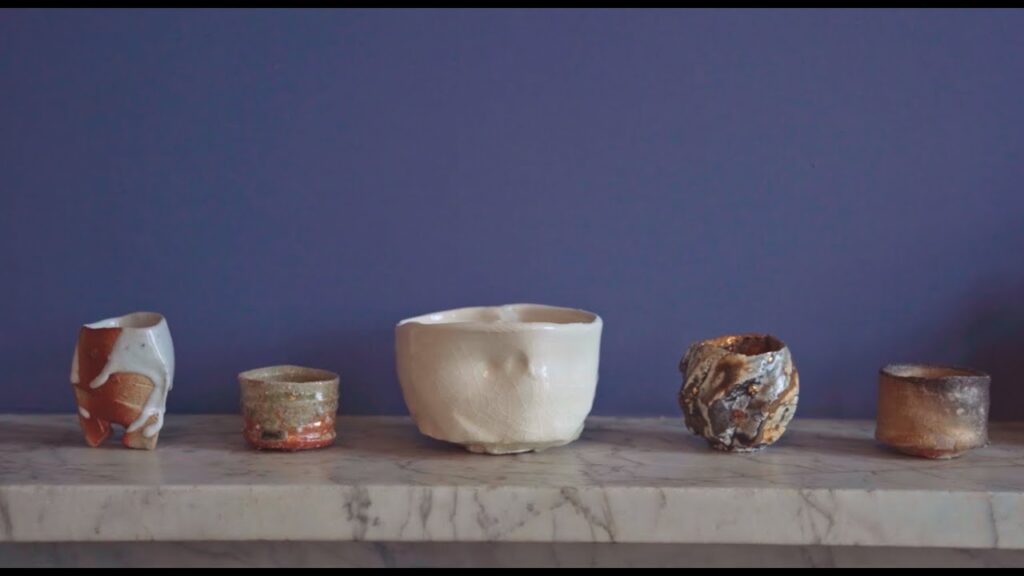Tim Warner-Johnson has been building an interesting collection of Japanese ceramics over the last few years, with limited budget and without going to Japan. His inspiring story shows what can be achieved with passion and focus. He discusses some of his favourite pieces with Sophie.
Tim and Sophie looked at works by the following artists (in order of appearance on the video):
Elspeth Owen (b. 1938)
The very first piece of ceramic acquired by Tim was by Elspeth Owen, a British studio potter active in Cambridgeshire.
Yui Tsujimura (b. 1975)
Living and working in Nara, he is the first son of famed potter Shiro Tsujimura. His signature ash-glazed pieces are fired in a kiln he built for himself in 2000.
Shiro Tsujimura (b. 1947)
One of the leading ceramic artists in Japan today, he lives in the mountains outside of Nara. Self-taught, he creates powerful functional vessels in a wide-ranging repertoire. He shows a particular fondness for a technique known as kohiki in which a vessel is dipped, either partially or in its entirety, in white slip.
Takuro Kuwata (b. 1981)
Living in Gifu Prefecture, Kuwata is best known for his contemporary take on the venerable Japanese tea bowl. Breaking away from traditional aesthetic, he adopts a strong palette, glistening glazes and fractured forms.
Ryuichi Kakurezaki (b. 1950)
Born in Nagasaki, he now lives in Bizen where he has developed his own original style. His sharply cut forms and three-legged vessels have become his trademark.
Kazu Yamada (b. 1954)
Hailing from a family of ceramicists, he produces mostly Mino wares and is especially admired for his mastery of various shino glazes, including the striking ‘dancing fire’ glaze.
Toru Ichikawa (b. 1973)
An apprentice of Ryuichi Kakurezaki, Ichikawa established his own kiln in Bizen in 2015. He creates beguiling, dynamic and colourful ceramics that have earned him a fast-growing popularity.
Ryoji Koie (1938-2020)
One of the most influential figures in the world of Japanese ceramics, Koie was a playful and provocative artist. His very diverse output shows his taste for experimentation and his inclination for breaking the rules.


Thank you Sophie for another great video – I love the intimate style. Great ceramics and fascinating to see the variety of technique and style.
Lovely to hear, thank you!
Paradise of pots. Beautiful and fascinating, Sophie – and the vessels aren’t bad either.
Thank you Melanie, I am so glad you enjoyed it.
Who would have known an Old Master paintings dealer collected Japanese ceramics?! so interesting Sophie. Really well done.
Love your videos
I am delighted to read this, thank you Yaniv. There will be more videos in the future!
I wonder if you annoyed him by picking up some of the pieces 😄
Pots are made to be handled! As long as she didn’t drop any hah
Pottery pieces begged to be picked up. It’s not picking them up that’s a problem but how you pick them up. It seems impolite to pick up a tea bowl with one hand and only right and respectful to use two hands.
I think it’s very likely she asked permission before the interview started
Can you link some of the artists mentioned in this video? Thank you 🙂
The aesthetic of the contemporary pottery was fundamentally very organic in basic form. But many of the expressions were highly developed and very sculptural. They were simply fascinating in the depth of artistic creation.
Sophie, Thank you for doing this interview, Unfortunately couldn’t hear a word you said, Fortunately I could hear Tim Warner-Johnson.
Hownice
!